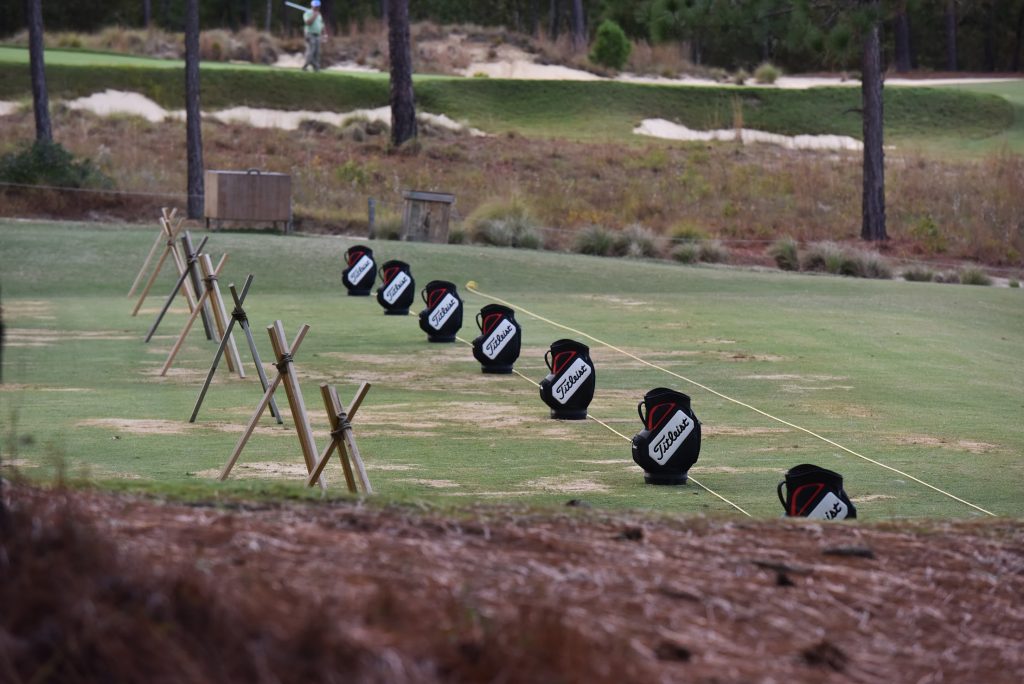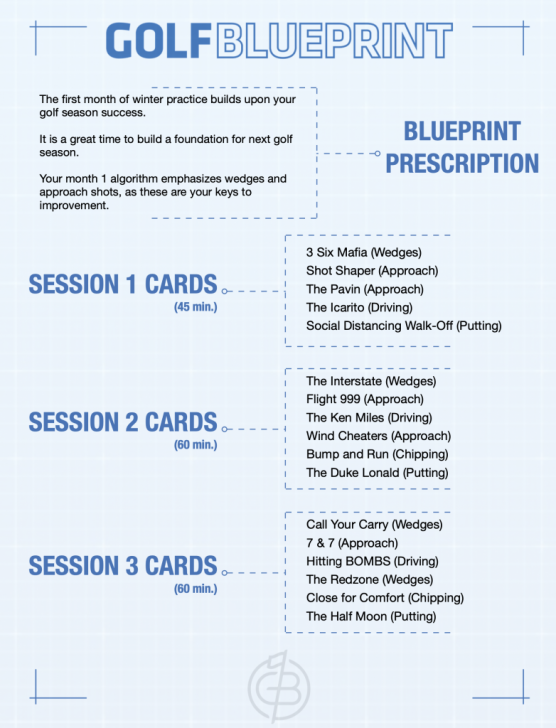Instruction
Golf Blueprint: A plan for productive practice sessions

Stop me if you’ve heard this one.
You’ve gotten lessons. Several of them. You’ve been custom fitted for everything in your bag. You even bought another half a dozen driver shafts last year looking for an extra couple of yards. And yet, you’re still…stuck. Either your handicap hasn’t moved at all in years or you keep bouncing back and forth between the same two numbers. You’ve had all the swing fixes and all the technological advances you could realistically hope to achieve, yet no appreciable result has been achieved in lowering your score. What gives?

Sample Golf Blueprint practice plan for a client.
One could argue that no one scientifically disassembled and then systematically reassembled the game of golf quite like the great Ben Hogan. His penchant for doing so created a mystique which is still the stuff of legend even today. A great many people have tried to decipher his secret over the years and the inevitable conclusion is always a somewhat anticlimactic, “The secret’s in the dirt.” Mr. Hogan’s ball striking prowess was carved one divot at a time from countless hours on the practice range. In an interview with golf journalist George Peper in 1987, Mr. Hogan once said:
“You hear stories about me beating my brains out practicing, but the truth is, I was enjoying myself. I couldn’t wait to get up in the morning so I could hit balls. I’d be at the practice tee at the crack of dawn, hit balls for a few hours, then take a break and get right back to it. And I still thoroughly enjoy it. When I’m hitting the ball where I want, hard and crisply—when anyone is— it’s a joy that very few people experience.”
Let me guess. You’ve tried that before, right? You’ve hit buckets and buckets of range rocks trying to groove the perfect 7-iron swing and still to no avail, right? Read that last sentence again closely and you might discover the problem. There’s a difference between mindful practice and mindless practice. Mindful practice, like Mr. Hogan undoubtedly employed, is structured, focused, and intentional. It has specific targets and goals in mind and progresses in a systematic fashion until those goals are met.
This is exactly what Nico Darras and Kevin Moore had in mind when they started Golf Blueprint. In truth, though, the journey actually started when Nico was a client of Kevin’s Squares2Circles project. Nico is actually a former DI baseball player who suffered a career-ending injury and took up golf at 22 years old. In a short time, he was approaching scratch and then getting into some mini tour events. Kevin, as mentioned in the Squares2Circles piece, is a mathematics education professor and accomplished golfer who has played in several USGA events. Their conversations quickly changed from refining course strategy to making targeted improvements in Nico’s game. By analyzing the greatest weaknesses in Nico’s game and designing specific practice sessions (which they call “blueprints”) around them, Nico started reaching his goals.
The transition from client to partners was equal parts swift and organic, as they quickly realized they were on to something. Nico and Kevin used their experiences to develop an algorithm which, when combined with the client’s feedback, establishes a player profile within Golf Blueprint’s system. Clients get a plan with weekly, monthly, and long-term goals including all of the specific blueprints that target the areas of their game where they need it most. Not to mention, clients get direct access to Nico and Kevin through Golf Blueprint.

Nico Darras, co-founder of Golf Blueprint
While this is approaching shades of Mr. Hogan’s practice method above, there is one key distinction here. Kevin and Nico aren’t recommending practicing for hours at a time. Far from it. In Nico’s words:
“We recommend 3 days a week. You can do more or less, for sure, but we’ve found that 3 days a week is within the realm of possibility for most of our clients. Practice sessions are roughly 45-70 minutes each, but again, all of this depends on the client and what resources they have at their disposal. Each blueprint card is roughly 10 minutes each, so you can choose which cards to do if you only have limited time to practice. Nothing is worse than cranking 7 irons at the range for hours. We want to make these engaging and rewarding.”

Kevin Moore, co-founder of Golf Blueprint
So far, Golf Blueprint has been working for a wide range of golfers – from tour pros to the No Laying Up crew to amateurs alike. Kevin shares some key data in that regard:
“When we went into this, we weren’t really sure what to expect. Were we going to be an elite player product? Were we going to be an amateur player product? We didn’t know, honestly. So far, what’s exciting is that we’ve had success with a huge range of players. Probably 20-25% of our players (roughly speaking) are in that 7-11 handicap range. That’s probably the center of the bell curve, if you will, right around that high-single-digit handicap range. We have a huge range though, scratch handicap and tour players all the way to 20 handicaps. It runs the full gamut. What’s been so rewarding is that the handicap dropping has been significantly more than we anticipated. The average handicap drop for our clients was about 2.7 in just 3 months’ time.”
Needless to say, that’s a pretty significant drop in a short amount of time from only changing how you practice. Maybe that Hogan guy was on to something. I think these guys might be too. To learn more about Golf Blueprint and get involved, visit their website. @Golf_Blueprint is their handle for both Twitter and Instagram.
- LIKE44
- LEGIT7
- WOW1
- LOL3
- IDHT1
- FLOP1
- OB2
- SHANK7
Instruction
Clement: Laid-off or perfect fade? Across-the-line or perfect draw?

Some call the image on the left laid off, but if you are hitting a fade, this could be a perfect backswing for it! Same for across the line for a draw! Stop racking your brain with perceived mistakes and simply match backswing to shot shape!
- LIKE0
- LEGIT0
- WOW0
- LOL0
- IDHT0
- FLOP0
- OB0
- SHANK1
Instruction
The Wedge Guy: The easiest-to-learn golf basic

My golf learning began with this simple fact – if you don’t have a fundamentally sound hold on the golf club, it is practically impossible for your body to execute a fundamentally sound golf swing. I’m still a big believer that the golf swing is much easier to execute if you begin with the proper hold on the club.
As you might imagine, I come into contact with hundreds of golfers of all skill levels. And it is very rare to see a good player with a bad hold on the golf club. There are some exceptions, for sure, but they are very few and very far between, and they typically have beat so many balls with their poor grip that they’ve found a way to work around it.
The reality of biophysics is that the body moves only in certain ways – and the particulars of the way you hold the golf club can totally prevent a sound swing motion that allows the club to release properly through the impact zone. The wonderful thing is that anyone can learn how to put a fundamentally sound hold on the golf club, and you can practice it anywhere your hands are not otherwise engaged, like watching TV or just sitting and relaxing.
Whether you prefer an overlap, interlock or full-finger (not baseball!) grip on the club, the same fundamentals apply. Here are the major grip faults I see most often, in the order of the frequency:
Mis-aligned hands
By this I mean that the palms of the two hands are not parallel to each other. Too many golfers have a weak left hand and strong right, or vice versa. The easiest way to learn how to hold the club with your palms aligned properly is to grip a plain wooden ruler or yardstick. It forces the hands to align properly and shows you how that feels. If you grip and re-grip a yardstick several times, then grip a club, you’ll see that the learning curve is almost immediate.
The position of the grip in the upper/left hand
I also observe many golfers who have the butt of the grip too far into the heel pad of the upper hand (the left hand for right-handed players). It’s amazing how much easier it is to release the club through the ball if even 1/4-1/2″ of the butt is beyond the left heel pad. Try this yourself to see what I mean. Swing the club freely with just your left hand and notice the difference in its release from when you hold it at the end of the grip, versus gripping down even a half inch.
To help you really understand how this works, go to the range and hit shots with your five-iron gripped down a full inch to make the club the same length as your seven-iron. You will probably see an amazing shot shape difference, and likely not see as much distance loss as you would expect.
Too much lower (right) hand on the club
It seems like almost all golfers of 8-10 handicap or higher have the club too far into the palm of the lower hand, because that feels “good” if you are trying to control the path of the clubhead to the ball. But the golf swing is not an effort to hit at the ball – it is a swing of the club. The proper hold on the club has the grip underneath the pad at the base of the fingers. This will likely feel “weak” to you — like you cannot control the club like that. EXACTLY. You should not be trying to control the club with your lower/master hand.
Gripping too tightly
Nearly all golfers hold the club too tightly, which tenses up the forearms and prevents a proper release of the club through impact. In order for the club to move back and through properly, you must feel that the club is controlled by the last three fingers of the upper hand, and the middle two fingers of the lower hand. If you engage your thumbs and forefingers in “holding” the club, the result will almost always be a grip that is too tight. Try this for yourself. Hold the club in your upper hand only, and squeeze firmly with just the last three fingers, with the forefinger and thumb off the club entirely. You have good control, but your forearms are not tense. Then begin to squeeze down with your thumb and forefinger and observe the tensing of the entire forearm. This is the way we are made, so the key to preventing tenseness in the arms is to hold the club very lightly with the “pinchers” — the thumbs and forefingers.
So, those are what I believe are the four fundamentals of a good grip. Anyone can learn them in their home or office very quickly. There is no easier way to improve your ball striking consistency and add distance than giving more attention to the way you hold the golf club.
More from the Wedge Guy
- The Wedge Guy: Golf mastery begins with your wedge game
- The Wedge Guy: Why golf is 20 times harder than brain surgery
- The Wedge Guy: Musings on the golf ball rollback
- LIKE87
- LEGIT13
- WOW6
- LOL1
- IDHT0
- FLOP4
- OB1
- SHANK8
Instruction
Clement: Stop ripping off your swing with this drill!

Not the dreaded headcover under the armpit drill! As if your body is defective and can’t function by itself! Have you seen how incredible the human machine is with all the incredible feats of agility all kinds of athletes are accomplishing? You think your body is so defective (the good Lord is laughing his head off at you) that it needs a headcover tucked under the armpit so you can swing like T-Rex?
- LIKE0
- LEGIT2
- WOW2
- LOL0
- IDHT0
- FLOP0
- OB0
- SHANK2
-

 19th Hole2 weeks ago
19th Hole2 weeks agoDave Portnoy places monstrous outright bet for the 2024 Masters
-

 19th Hole4 days ago
19th Hole4 days agoJustin Thomas on the equipment choice of Scottie Scheffler that he thinks is ‘weird’
-

 19th Hole2 weeks ago
19th Hole2 weeks agoTiger Woods arrives at 2024 Masters equipped with a putter that may surprise you
-

 19th Hole4 days ago
19th Hole4 days ago‘Absolutely crazy’ – Major champ lays into Patrick Cantlay over his decision on final hole of RBC Heritage
-

 19th Hole2 weeks ago
19th Hole2 weeks agoTwo star names reportedly blanked Jon Rahm all week at the Masters
-

 19th Hole1 week ago
19th Hole1 week agoReport: LIV Golf identifies latest star name they hope to sign to breakaway tour
-

 19th Hole2 weeks ago
19th Hole2 weeks agoNeal Shipley presser ends in awkward fashion after reporter claims Tiger handed him note on 8th fairway
-

 19th Hole1 week ago
19th Hole1 week agoBrandel Chamblee has ‘no doubt’ who started the McIlroy/LIV rumor and why
















Rusty
Jan 10, 2021 at 10:12 am
$100 a month for a practice plan? Give me a break.
Will
Jan 9, 2021 at 3:10 pm
Worth every penny!
Radim
Jan 9, 2021 at 2:40 pm
$340? No, thanks.